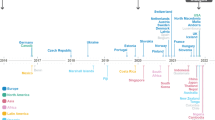Abstract
Human-induced change in the composition of the atmosphere seriously threatens the global climate. In an effort to address this threat, 161 nations signed the United Nations Framework Convention on Climate Change at the Earth Summit in Rio de Janeiro in June 1992. The ultimate objective of this international agreement is to achieve stabilization of greenhouse gas concentrations in the atmosphere at a level that would prevent dangerous anthropogenic interference with the climate system. As of the first session of the Conference of the Parties (March/April 1995), 128 nations had ratified the Convention. Parties to the Convention commit to numerous obligations, including commitments to: develop national inventories of anthropogenic emissions using agreed, comparable methodologies’, and to formulate and implement national programs containing measures to mitigate, and to facilitate adaptation to, climate change. Several bilateral and multilateral programs, including the United States Country Studies Program (U.S. CSP) and the United Nations Environment Programme/Global Environment Facility Country Case Studies Project (UNEP), have been established to provide technical and financial assistance to developing countries and countries with economies in transition in meeting their commitments under the Convention.
Access this chapter
Tax calculation will be finalised at checkout
Purchases are for personal use only
Preview
Unable to display preview. Download preview PDF.
Similar content being viewed by others
References
UNEP/OECD/IEA/IPCC: 1995, IPCC Guidelines for National Greenhouse Gas Inventories, IPCC, Bracknell, 3 Volumes.
Scholes, R.J.: 1995, Estimating greenhouse gas emissions from vegetation fires in Africa, Environmental Monitoring and Assessment, in press.
Author information
Authors and Affiliations
Editor information
Editors and Affiliations
Rights and permissions
Copyright information
© 1995 Kluwer Academic Publishers
About this chapter
Cite this chapter
Braatz, B.V. et al. (1995). African Greenhouse Gas Emission Inventories and Mitigation Options: Forestry, Land-Use Change, and Agriculture. In: Fitzgerald, J.F., Braatz, B.V., Brown, S., Isichei, A.O., Odada, E.O., Scholes, R.J. (eds) African Greenhouse Gas Emission Inventories and Mitigation Options: Forestry, Land-Use Change, and Agriculture. Springer, Dordrecht. https://doi.org/10.1007/978-94-009-1637-1_1
Download citation
DOI: https://doi.org/10.1007/978-94-009-1637-1_1
Publisher Name: Springer, Dordrecht
Print ISBN: 978-94-010-7232-8
Online ISBN: 978-94-009-1637-1
eBook Packages: Springer Book Archive




